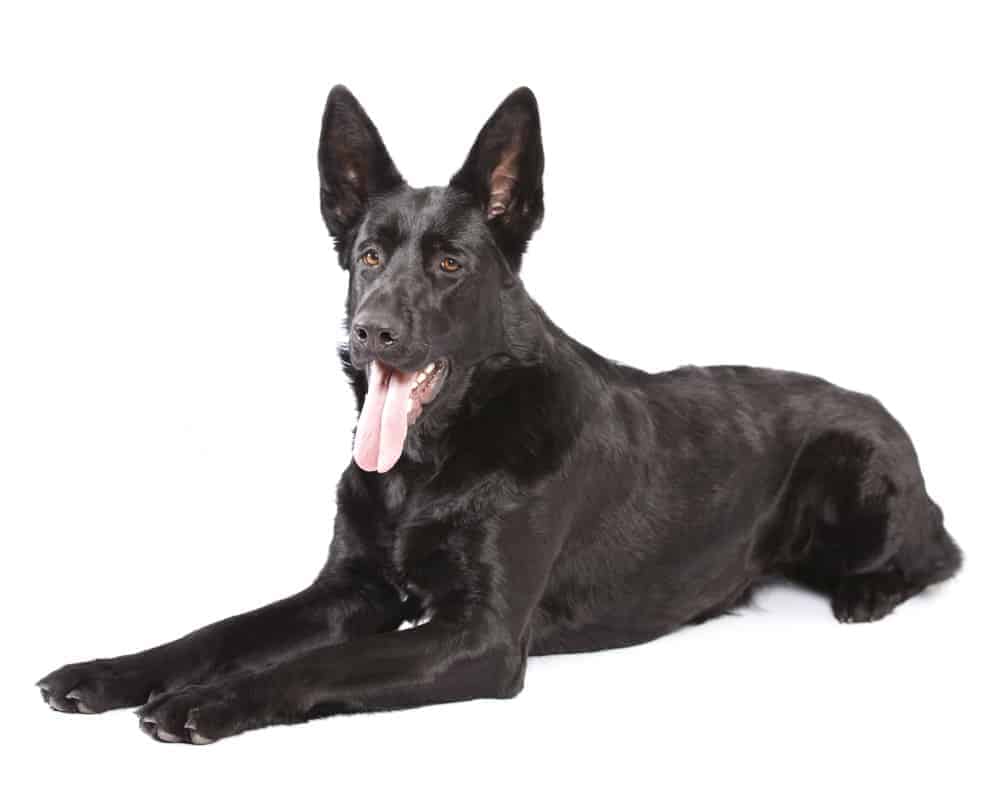One of the cutest things about German Shepherds is their ears. The German Shepherd breed standard requires them to have pointy ears, and a dog with floppy ears is disqualified. So, why do German Shepherds have pointy ears?
German Shepherds have pointy ears due to their flexible and robust cartilage, making them stand up and be pointed. In puppies, the cartilage is still soft, which causes their ears to be floppy. Once pups have finished teething at around 5 months old, their ears should stand up.
Sometimes a German Shepherd’s ears will fail to stand up and remain floppy. We will look at ways to help prevent this and fix your German Shepherd’s ears if they do not stand up.
Welcome to the world of German Shepherds and pointy ears. Let’s get started!

Why Do German Shepherd’s Ears Stand Up?
Before dogs were domesticated, they used their pointy ears when hunting food. They needed to be perked upright (or pricked, as the term is often used) to protect themselves from a threat. When a German Shepherd’s ears are pricked, they are alert, engaged, and listening to every sound.
Pricked or upright ears are the basic shape of a German Shepherd’s ears inherited from his wild ancestor, the wolf.
I’m often asked why my German Shepherd looks like a wolf, especially by young children as I pass them by on my walk. Check out this article, Why Do German Shepherds Look Like Wolves? to find the answer.
Typically, when a German Shepherd puppy reaches about 20 weeks, and when they are coming to the end of the teething phase, their ears should stand up. Often there is variation each day, and some days the ears (either one or both) may remain down before consistently standing upright.
This time may be dramatically different in each dog and may occur sooner than 5 months or may take as long as 8 months in some cases.
Here’s a picture of my German Shepherd showing her cute floppy ears at 12 weeks. It took a couple more months before they fully stood up nice and pointy. Puppies’ pointy ears can look huge until they eventually grow into them!

Unfortunately, on occasions, some German Shepherd’s ears will remain floppy, some will have one ear up while the other stays down, and occasionally one or both ears may remain only halfway up. Entirely floppy-eared German Shepherds are rare, and it is more common for them to have partially floppy ears.
Related: German Shepherds Ears Meaning: 4 Examples with Pictures!
Through proper breeding strategies, this can be somewhat controlled, but there are still some other factors that can determine whether your dog’s ears will stand up or remain floppy:
- Trauma: Injuries to your dog’s ears can cause permanent damage that will prevent his ears from standing fully upright.
- Infections: Major ear infections can also lead to permanent damage, preventing your German Shepherd’s ears from becoming pointy.
- Poor Muscle Tone: A lack of muscle in your dog’s ears can also limit its ability to perk up. It forces the cartilage in their ears to do more work to support the weight of the ear.
Earlier, I referred to the German Shepherd breed standard concerning their ears. The below quote is from the American Kennel Club:
“Ears are moderately pointed, in proportion to the skull, open toward the front, and carried erect when at attention.”
American Kennel Club
Remember, though, that the breed standard is just a guideline that describes the ideal characteristics and appearance. Therefore, as long as you are not a breeder or wish to show your dog, I wouldn’t worry too much if your pup’s ears remain floppy.
Why Do Some Dog Breeds Have Floppy Ears?
Some dog breeds, such as the Beagle, English Cocker Spaniel, and Poodle, have floppy ears. In the late 1800s, the English geologist and biologist Charles Darwin concluded that:
“The incapacity to erect the ears is certainly in some manner the result of domestication.”
NPR: Why Dogs Have Floppy Ears
Here’s a fascinating animated video that explains why some dog breeds have floppy ears and how scientists believe centuries of domestication is the cause:
As dog breeding trends move further away from abiding by strict breed standards, floppy-eared dogs are bred more due to their extreme desirability.
Some people admire their large, floppy ears because they are cute, but I think the opposite. There is nothing quite like a German Shepherd’s pointy ears.
Having floppy ears also comes with some health issues discussed in the next chapter.
Health Concerns Associated with Floppy Ears on a German Shepherd?
When a dog’s ears lay flat, less air can circulate through their ears, and more moisture can build up. This can lead to a couple of issues, including:
- Need for more frequent cleaning: It is always essential to clean your dog’s ears, whether they are pointy or not, but if your dog has floppy ears, they will need to have their ears cleaned more often than dogs with pointy ears.
- Higher risk of ear infections: Even with frequent cleanings, floppy-eared dogs are prone to ear infections due to the heat and moisture trapped by their ears lying down.
- High risk of ear injuries: Having floppy ears makes your dog’s ears vulnerable to potential harm. Their ears are more likely to get caught in something or bitten and torn when playing rough or fighting.
- High risk of hearing damage: If an ear infection or injury is severe enough, your dog could experience hearing damage and even total hearing loss.
Floppy dog ears may be cute, but they require extra care and attentiveness than pointy dog ears.
Ideally, your German Shepherd’s ears will naturally become pointy as they get older, but there are some things you can do to encourage this process.
How Do You Fix a German Shepherd’s Ears?
If you have any concerns that your German Shepherd’s puppy ears will not stand up, you can take some simple steps to promote cartilage formation.

These methods will help your puppy’s ears naturally stand upright.
Feed a Healthy Diet and Supplements
Always check with your veterinarian before altering your dog’s diet or adding any supplements.
You should always focus on feeding high-quality dog food. Food is the number one thing you can do to increase and maintain your dog’s overall health. A healthy dog will also have stronger cartilage, making it more likely that their ears will become pointy as they get older.
On top of feeding your dog well, you can also supplement their diet if they have some deficiency (but be careful with what you give your dog):
Add Glucosamine
Adding glucosamine to your German Shepherd’s diet is often prescribed to dogs with arthritis because it helps maintain and build cartilage in joints. Glucosamine can also help strengthen the cartilage in your dog’s ears, encouraging them to stand upright.
You can get them as chews, treats, or a liquid that you add to your dog’s food. Check out YuMove Hip and Joint Supplement Chews on Amazon. They are proven to work in just a few weeks from independent studies.
Add Vitamin C
Vitamin C can also help build up your dog’s cartilage and encourage his ears to perk up. You can add Vitamin C to your puppy’s diet through either vitamin supplements or natural foods. Do not give your puppy citrus fruits, as they can cause stomach upset, vomiting, and diarrhea as they contain high amounts of citric acid.
Apples, carrots, watermelon, and sweet potatoes are far better options to give your dog a boost of Vitamin C. You can check out what fruits German Shepherds can eat and which to avoid in my complete guide. If vegetables are more your thing, here’s a list of vegetables that GSDs can eat.
However, if you want to go down the supplement route, you can get a good multivitamin that contains both glucosamine and Vitamin C.
Don’t Add Calcium!
Many people believe that adding calcium to your dog’s diet can help their ears stand upright. This is not true.
A dog’s ears are made of cartilage, not bone! Cartilage does not contain calcium, so adding calcium to your dog’s diet will not help its ears become pointy. Adding calcium to their diet without a veterinarian’s recommendation can also harm your German Shepherd and cause skeletal problems.
Prevent and Treat Parasites
Parasites can hinder your dog’s overall health, and this can lead to the weakening of both muscle tone and cartilage strength in your dog’s ears. It is best to keep an eye on your dog and regularly check for parasites.
Keep on top of your German Shepherd’s flea treatment as a means of prevention. If your dog has a parasite or you suspect he does, take him to the vet for a check-up.
Encourage Exercising of the Ear Muscles
Since muscle tone is one of the reasons why your German Shepherd’s ears may not stand up, encouraging your dog to exercise his ear muscles can help. You may not know this, but dogs have more than a dozen ear muscles for turning, raising, and lowering the ears.
You can invite your dog to use his ear muscles through a couple of techniques:
- Chew Toys: Chewing toys can exercise a dog’s jaw muscles. These muscles are attached to your dog’s ear muscles, so encouraging your dog to chew good dog toys can also strengthen your dog’s ear muscles and increase the likelihood that its ears will stand up.
I love KONG chew toys as they are great for German Shepherds, and you can get a varied and exciting selection. You can’t go wrong with the KONG Classic from Amazon, as it’s great for chewing, chasing, and fetching, and you can even stuff it with treats! - Clicker Training: Making interesting little noises around your dog can encourage him to perk up his ears and move them around. You can even buy a clicker for dog training to make some of these noises. This type of training is a great way to train your German Shepherd.
Prevent Trauma
If you want your German Shepherd’s ears to stand upright naturally, another critical thing for you to do is to prevent any trauma to his ears.
Pulling on or rubbing your dog’s ears can lead to ear injuries and weaken the cartilage, so it’s best to avoid too much rough play. Other injuries like bites and tears can damage your dog’s ears and permanently destroy its ability to stand up independently.
Other Methods:
If your German Shepherd’s ears do not perk up naturally by the time they are about 7-8 months old, you may wish to consider other methods to encourage their ears to stand erect.
These methods should only be considered a last resort after your puppy has finished teething and is at least 8 months old. These methods come with risks and are not 100% guaranteed to work:
Taping
Taping your dog’s ears can be done at home or with a vet. It can take between one to two weeks to take effect. It consists of taping your dog’s ears to help them stand upright on their own.
If you decide to tape your dog’s ears, please do your research and consult your veterinarian to ensure you do it properly. Taping your dog’s ears too early or improperly can lead to severe ear damage.
Read more: The Ultimate German Shepherd Ears Guide
Surgical Implants
If taping does not work, you can also consider using surgical implants for your German Shepherd’s ears. This should only be considered as an absolute last resort and must be done by a certified veterinarian. It is important to note that implants may not work for your dog, as they are not 100% successful.
Final Thoughts
German Shepherd’s pointy ears are one of the gorgeous parts of the breed. Occasionally the ears of a GSD remain floppy, but you mustn’t worry as there are some things you can do. Here’s a quick recap of the main parts of the article:
- Healthy and strong cartilage makes the German Shepherd’s ears stand up.
- The breed standard for German Shepherds requires them to have pointy ears – something to be aware of if you wish to show your dog.
- Floppy ears can cause some health issues.
- Always feed your German Shepherd high-quality food for good overall health.
- Consider supplements such as glucosamine and vitamin C, but check with your vet first.
- Provide a range of interesting chew toys and start clicker training.
- You must wait until your pup is at least 8 months old before seeking other methods such as ear taping or surgical implants.
Related Posts You May Like:





